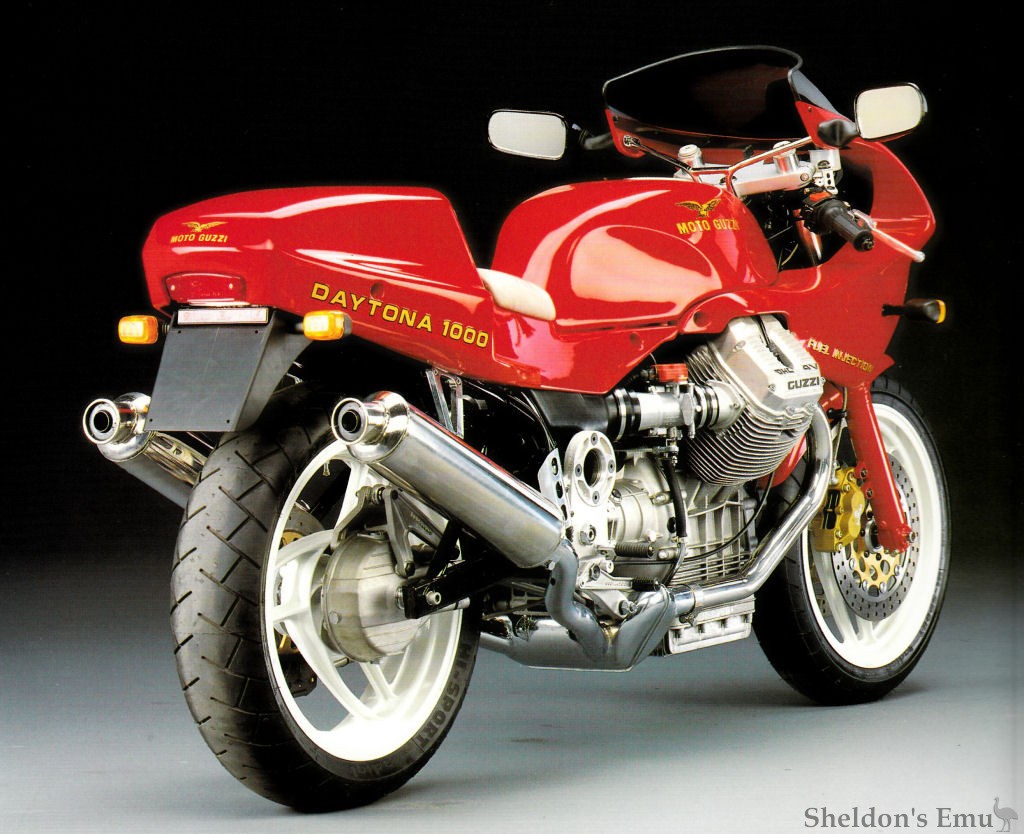


Dr. John Wittner headed a team which built Moto Guzzi racers with which they won the 1984 and 1985 U.S. Endurance Championship and the 1987 Pro Twins series.
Suitably impressed, Alejandro de Tomaso invited him to Italy to develop a new high-performance model.
The factory revealed a prototype of the aptly named Daytona at the 1989 Milan show and after considerable testing and further development it entered production in late 1991.
The Daytona engine retained the crankshaft and crankcases of the standard V-twin, with the bore increased to 90mm giving the short-stroke (78mm) a capacity of 992cc.
The top-end was a considerable departure from Guzzi convention, sporting 4-valve OHC cylinder heads - which were in truth "high-cam" heads, but the result was much the same. The cams were driven by toothed belts, and short pushrods activated rocker arms.
Weber-Marelli electronic fuel injection was employed, and a stainless-steel exhaust system with an underslung collector box.
Transmission was via a stronger clutch and revised 5-speed gearbox,
The frame was completely new, based on that of the Dr. John racing machines, with monoshock swinging arm suspension. The front end was conventional, with Marzocchi forks, 4-piston Brembo calipers and 300mm discs. Alloy wheels had 120x17 and 160x18 tyres.
Specification
Engine: 90° V-twin, 4-stroke, air-cooled
Displacement: 992 cc, Nigusil® cylinder lining
Bore and stroke: 90 x 78 mm
Compression ratio: 10: 1
Max. output: 68 kW (95 HP) at 8000 r.p.m. (DIN)
Max. torque: 98 Nm (10 kgm) at 6000 r.p.m. (DIN)
Fuel system: Weber Marelli electronic injection with dual injector, "Alfa-N" system, electric fuel pump with pressure regulator, optimized digital control of the injection times and high efficiency air filter
Ignition: Weber Marelli digital electronic ignition, inductive system with high efficiency power modules and coils
Exhaust system: in stainless steel, two separate tubes and silencers connected by a central collector
Valves and operation: four valves per cylinder with single overhead camshaft driven by aluminium gears and toothed belts
Lubrication: high volume pressure pump
Starting system: electric
Clutch: double disc, dry type in extra light flywheel
Primary transmission: straight tooth gears
Gearbox: 5-speed, straight tooth gears
Final drive: by shaft, with two separate cardan joints and system of floating ring and pinion housing with parallel torque arm to counter torque reaction at the wheel
Frame: chrome-molybdenum steel single beam, rectangular section with engine as a stressed member
Suspension: front: Marzocchi hydraulic telescopic fork, adjustable for compression and rebound; rear: chrome-molybdenum steel swinging fork of rectangular section with Koni hydraulic monoshock adjustable for pre-load, compression and rebound
Instrument panel: speedometer, electronic rev-counter and warning lights
Electrical system: 12V, 14V 25A alternator, 16Ah battery
Brakes: front: hydraulic with adjustable lever position. Dual 300 mm, drilled, floating Brembo discs and 4-piston calipers of differential diameters; rear: hydraulic with single 260 mm drilled disc and floating 2-piston caliper
Tyres: front 120/70 ZR 17 Tubeless Radial rear 160/60 ZR 18 Tubeless Radial
Wheels: light alloy cast
Fuel tank capacity: 23 litres
Fuel consumption: 5 lt/100 km (CUNA Standard)
Max. speed: over 240 km/h (145 m.p.h.)
Dry weight: 205 kg
Source: Factory Literature